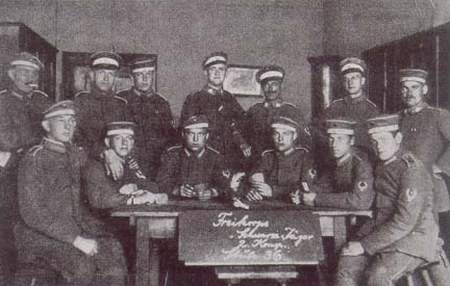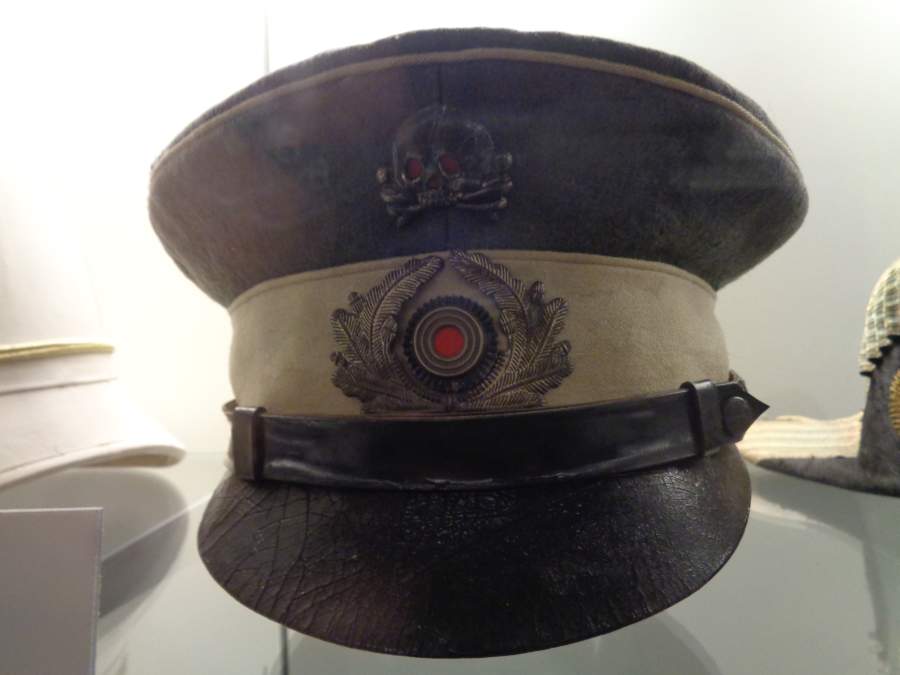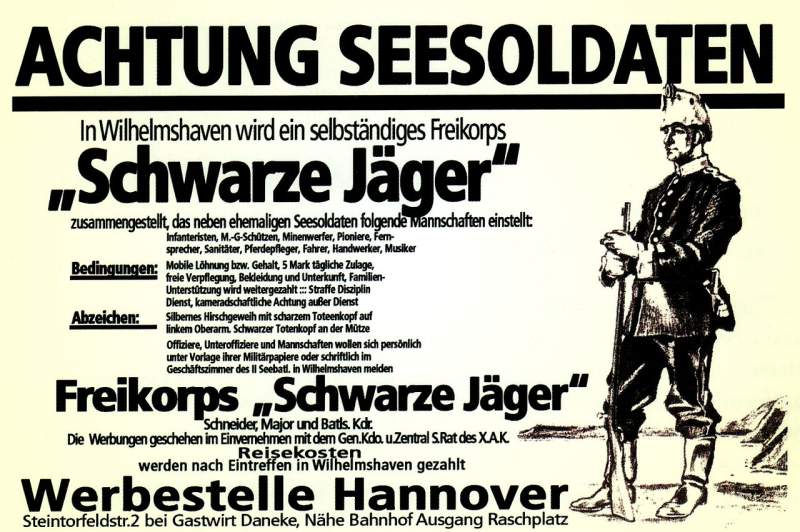| |
Freikorps Schwarze Jäger
Marine Infantry in the Freikorps
1919
|
|
| |

Seesoldat,
Freikorps Schwarze Jäger, 1919
He wears the field grey M1915 Marine Infantry uniform
with the white stag's skull and black Totenkopf arm badge of the
Schwarze Jäger. His headdress is the M1895 Marine Infantry shako,
probably with the crown clipped off the imperial eagle as was often
done in the new republican Germany. |
|
As Germany descended into the chaos of revolution following
the Armistice of November 1918 armed groups of disbanded former soldiers returning
from the frontlines joined together into Free Units (Freikorps)
to oppose communist revolutionaries and restore order. The order they
restored was often in an extremely brutal manner and the summary
execution of opponents was commonplace.
Former members of
the Marine Infantry also found themselves caught up in the
ensuing civil war as they returned home. In 1919, these Seesoldaten were
formed into the Freikorps Schwarze Jäger.

NCOs and other Ranks of the
2. Komp, Freikorps Schwarze Jäger, 1919
Originally published in
Buch vom deutschen Freikorpskämpfer,
edited by Ernst von Salomon, 1935. Shown on the
Axis History Forum |
|
| |
|
|
|
|
Background to the
Freikorps Schwarze
Jäger
Freikorps Schwarze Jäger
was formed in Wilhelmshavn in January 1919, mostly from former soldiers of
the 1st and 2nd Marine Infantry Regiments. The unit
derived its name from the nickname of "Les Chasseurs Noires"
given to the marine infantry on the Western Front early in the First
World War by their French and Belgian enemies on account of their black
greatcoats and Jäger style shakos.
The Freikorps were commanded by
Oberstleutnant
Paul Schneider, who had previously commanded the Marine Detachment Skutari
and later served with the Marine Infantry in Flanders on the Western Front.
At full strength it consisted of four infantry companies, a machine
gun company, a reserve company and a platoon each of pioneers and
mortars (Minenwerfer).
On 27 January 1919, the unit took
part in the successful storming of the Marine Infantry Barracks in
Wilhelmshavn which had become the headquarters of the local
revolutionary comittee. From June 1919 they were deployed to the
Eastern border with Poland. Towards the end of 1919 they were formed
into part of the new army of the German Republic (Reichswehr)
as the 1st Battalion of the 18th Infantry Regiment based at
Flensburg.
Uniforms of the Freikorps Schwarze
Jäger
The Freikorps generally wore a wide mixture of any uniforms available. Most wore
former Imperial army stocks, usually 1915 or modified 1910 field grey
tunics with 1910 field grey caps and 1916/18 steel helmets. Individual Freikorps
units were often identified with insignia on the left arm.
The Freikorps Schwarze
Jäger wore field grey Marine Infantry Uniforms where possible (see
Marine Infantry on the
Western Front), including shakos and caps with white piping and
cap band. However the cap now bore a black skull and crossed bones
insignia (Totenkopf), a common Freikorps device borrowed from
the Leib-Hussars of the Imperial Army. The insignia worn on the
upper left arm was a white stag antler and black Totenkopf.

Freikorps Schwarze Jäger Officer's Cap
It is an M1910/14 Marine Infantry Officer's cap in field grey with a
black leather peak and chinstrap. Piping and hatband are in white for
the Marine Infantry with an officer's imperial cockade on the hatband in
the centre. Of special interest is the blackened metal Totenkopf badge
of the Freikorps. The red eyes are probably exclusive to officers. The
silver thread wreath around the cockade is a distinction not worn by
Marine Infantry officers but was usually exclusive to officers of the
Imperial Navy.
Photo by Chris Dale at the
Internationales Maritimes Museum, Hamburg (IMM-Hamburg.de)

Recruitment Poster for the Freikorps Schwarze
Jäger
Image from
WikiCommons
References and Links-
Freikorps Schwarze Jäger Discussion
on the Axis History Forum
Marine Infanterie page on the Freikorps Schwarze Jäger
 German
Wikipedia page on the Freikorps Schwarze Jäger German
Wikipedia page on the Freikorps Schwarze Jäger
|